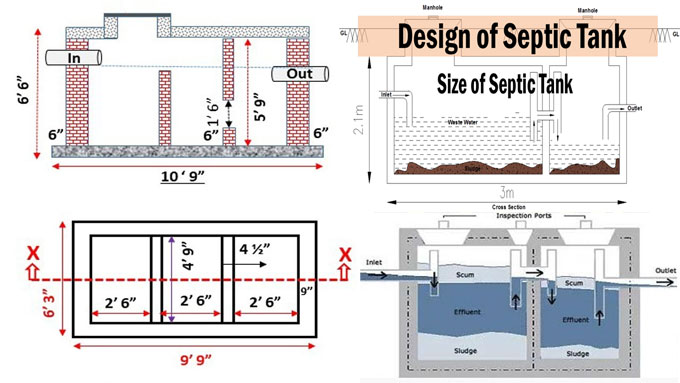
How to Design Septic Tanks
Septic tanks are very important. They should be constructed in every house. Here is how to design septic tanks. Today we will learn about what should be the location of a septic tank in a house, what is the process of a septic tank, and what are the do?s and don?ts while designing a septic tank.
Location of a septic tank?
Most septic tanks are suitable for rural & urban areas where the exact exhaust system is not available. At present, every domestic / commercial building has a septic tank, to maintain waste for a few moments before going down to the sewer to avoid blockages. Basically, septic tanks are built from concrete / brick walls with rectangular shapes and must have a minimum of two rooms.
Process of a septic tank
Effluent can be in the form of liquid or solid waste received from households to septic tanks through incoming channel pipes. Septic tank is designed to store wastewater in a minimum period of 18 hours to 24 hours, called the detention period.
During this period, mud was decomposed by biological actions of anaerobic bacteria and solid waste settled as mud. Then the surface water flows into a soaking hole through the outlet pipe. Then the solved mud must be removed after 1 or 2 years.
What is the purpose of a soaking pit
A soaking pit is a hole excavated under natural land, is built with a round shape with dry bricks or stones with free mortar together, where water can easily soak to the ground known as soak. The top is closed by RCC slab & accessible. It shouldn't be less than 900mm, depth of 1500mm. At the same time, it should not be under 2m from ground water.
Important features to be included in the design of a septic tank
1. Tanks must be built in the right place & the size needed.
2. Reduce the use of water to avoid full tanks in a short time and also save water.
3. Removal mud regularly at a certain period of time.
4. Check the septic tank regularly.
5. Raise up septic tank without disturbing ground water.
6. If there is a blockage that occurs in the septic tank immediately to resolve the problem.
7. A manhole must be provided to access the tank easily.
Prohibitions in design of a septic tank
1. Because of insufficient tank capacity, reduced waste water can return to our house so that the tank capacity is very important.
2. Do not flush garbage, sanitary goods, paper or other solid materials to avoid unnecessary blockages.
3. Other water sources should not enter the septic tank.
4. Wastewater should not run on natural land to secure the environment.
Design calculations of a septic tank for a 5-people home
As per the guides mentioned above, the capacity of the septic tank should be designed correctly because insufficient tank size may build up wastewater back up to the house or it will force us to clean the water often and also it will increase the maintenance cost.
Water usage
Cooking ? 5 Liters
Bath & Toilet ? 425 liters
Washing clothes & Utensils ? 30 Liters
Cleaning House ? 10 Liters
Other ? 5 Liters
Total ? 475 Liters (appx.)
If we assume the detention period as 3 days, then the septic tank should have the capacity to retain the household wastewater at least 3 days.
Total wastewater in 3 days ? 475?3 = 1425 Liters
Thereby, presume 2000 Liters capacity minimum for a home. The minimum depth of the Septic tank should not be less than 1.8m.
Sludge settled down per person ? 30 liters/year. So here we take sludge removal 2 years once.
So total sludge = 30 liters x 5 persons x 2 years = 300 liters
Total tank capacity = 2000+300 = 2300 Liters
We knew that 1 m3 = 1000 Liters = 2300/1000 = 2.3 m3
Area required @ 1.8m depth = 2.3/1.8 = 1.2 m2
Length & breadth ratio of Septic Tank is 4:1 or 2:1
L:B ratio taken as 4:1
So 4BxB = 1.2 Sqm where B=0.54m
Note ? Breadth of the tank should minimum 750mm, So that L = 4?0.75 = 3m
L ? 3m; B ? 0.75m; Depth = 1.8+0.3 = 2.1m (free board should be provided at least 300mm)
Tank capacity = 3 x 2.1 x 0.75 = 4.725 Cum = 4.725x 1000 = 4725 Liters
British Standard Calculation
As per British standard, they follow the below formula to calculate the wastewater flow for a septic tank.
C=A+P(RQ+NS)
Where,
C ? Capacity in liters
P ? Number of People
A ? 2000 Liters as constant
R ? Detention period of Sewage in Days
Q ? Sewage Flow in liter per day
N ? Number of years
S ? Sludge accumulation in liters per person/year
Therefore, tank capacity as per above formula = 2900 Liters


